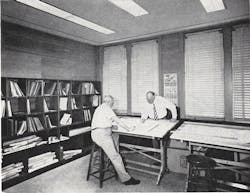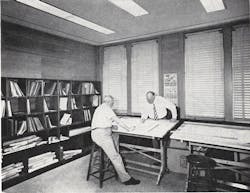The estimating process – like other industry processes – has improved over the years through better communications, computers, and software. But computers and software will not make you an estimator any more than owning a hammer and a saw will make you a carpenter. To be a skilled carpenter, you must understand the principles of house building. To be a skilled estimator, you must have a good understanding of these components: philosophy, methodology, and use of software. Over the years, estimating methodology and the implementation of software have revolutionized the process. While the methodology has changed with software, there are some estimating principles that remain timeless.
In the 1960s, EC&M published a book titled How to Estimate Electrical Work. This 98-page booklet contained 56 practical articles on electrical estimating methods. Some may find this book outdated and would never consider reading it. However, it contains many time-tested and proven estimating principles that are still true and should be considered in the estimating process.
In this article, we will look at some of these timeless principles I have extracted from random articles in that book.
Provide a detailed scope of work
When there are no plans and specifications, the estimator should provide sketches or plans of the work to be installed. This scope of work letter or bid proposal should include details of quantities, wiring methods, and materials used in the estimate. The scope of work cannot be vague. When the scope of work is not well defined, scope seep is inevitable.
Tracking your own labor data is best
The Manual of Labor Units published by NECA is data collected by the organization to provide contractors with an “approximate value” for labor units. However, the best contractors track labor installations on their projects to provide the best historical data for their company and market. When a project has labor overruns, a project’s historical labor data will provide valuable information for future estimates.
Equipment weight affects labor units
The weight of material and equipment is important when determining labor for installation. For example, an industrial 2-lamp LED luminaire weighs approximately 5 lb, while a 2-lamp LED luminaire for a Class I, Division 1 location weighs approximately 32 lb. Another example would be a 100A NEMA 1 disconnect switch, which weighs approximately 15 lb. The same size switch in a NEMA 7 explosion-proof enclosure weighs approximately 50 lb. The estimator must always consider equipment weights when assigning labor units to an item. The types and sizes of hangers are also impacted by equipment weight.
Labor adjustments due to job factors should be calculated
Job factors or project labor factors are project conditions that have a negative impact on labor productivity. There are as many as 40 project labor factors used today. This booklet lists six. They are standby, weather, size, coordination, complexity, and efficiency. The job factors are labor hours added to the direct labor hour total. These factors are cumulative. For example, if 20% of the work will be performed outside in inclement weather, only these labor hours are adjusted accordingly. A weather adjustment would vary based on geographic location.
Project labor factors applied in occupied facilities
Determining labor for a new building compared to an occupied facility must be considered. When work is installed in an area occupied with desks and filing cabinets, it will require dust control, protection of the area, and white-glove inspection cleaning once the work is installed. Another example would be a warehouse filled with products that may have to be moved with forklifts to provide access to the work area.
Installation labor factors applied based on mounting height
When luminaires or conduits are installed above a normal working height, adjustments must be made to the labor units. Different heights will require different adjustments. A luminaire mounted at 20 ft will require more labor than installed at 8 ft. Installation labor factors are adjustments made to labor units based on the ease or difficulty of the installation. These factors may increase or decrease the labor unit of the item being installed. One example of decreasing the labor units would be parallel run feeders either overhead or installed in a trench.
Non-productive labor is a misnomer
The term “non-productive labor” has been used very carelessly. Every contractor should want the “non-productive labor” to be nil or zero. Direct labor is the amount of time or labor hours that is required to install the material as per the plans and specifications. In addition to the direct labor hours, a project will have other labor items that should be considered, indirect labor and incidental labor, but never should it be referred to as “non-productive labor.” Proper categorization of labor will provide the contractor with the best data to track the project’s progress. Also, referring to labor as “non-productive,” it makes it difficult to sell to owners and architects on change orders. Please abandon this misnomer immediately.
Have a post-project meeting
This meeting has been sometimes referred to as a “postmortem analysis.” The contractor will gather valuable information by comparing the actual labor hours required to install a project to the estimated labor hours. One important item is the average crew size for the duration of the project. Having fewer men is more productive than having too many. During this meeting, the project manager should provide data to the estimating department for future bidding. This data should include the following: journeyman to apprentice ratio, total labor hours, average hourly labor costs, and project labor conditions that had an impact on productivity. This information will increase bidding accuracy on future projects.
Every contractor should always be seeking to improve estimating efficiency. Using the best technology of our day is paramount, but let’s not forget the timeless principles of our industry that are unchanged. Our current generation of estimators is indebted to the estimators of yesteryear for their labor and expertise in providing us with sound principles to do our job.
Don Kiper is an independent electrical estimating trainer and consultant based in Niagara Falls, N.Y. He can be reached at [email protected].
About the Author
Don Kiper
Independent Electrical Estimating Consultant
With more than 35 years of experience as a construction electrician, industrial maintenance electrician, foreman, estimator, estimating manager, and project manager, Don has used what he learned to lead in the implementation of estimating software with three electrical contractors where he has worked. Don has 17 years of experience in the construction field and 18 years of office experience and he has personally estimated over $700 million dollars in electrical projects.

